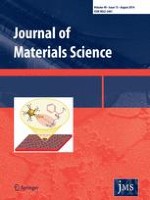Published in:

01-08-2014
Synthesis, characterization, and photovoltaic properties of acceptor–donor–acceptor organic small molecules with different terminal electron-withdrawing groups
Authors:
Leijing Liu, Hui Li, Xiaoyu Zhang, Yingjin Wei, Jiyang Li, Wenjing Tian
Published in:
Journal of Materials Science
|
Issue 15/2014
Log in
Abstract
Two soluble acceptor–donor–acceptor (A–D–A) type organic small molecules, 2,2′-(5,5′-(1E,1′E)-2,2′-(benzo[c][1,2,5]thiadiazole-4,7-diyl)bis(ethene-2,1-diyl)bis(3,4-dihexylthiophene-5,2-diyl))bis(methan-1-yl-1-ylidene)dimalononitrile (BvT-DCN) and 2,2′-(3,3′-(1E,1′E)-2,2′-(5,5′-(1E,1′E)-2,2′-(benzo[c][1,2,5]thiadiazole-4,7-diyl)bis(ethene-2,1-diyl)bis(3,4-dihexylthiophene-5,2-diyl))bis(ethene-2,1-diyl)bis(5,5-dimethylcyclohex-2-ene-3-yl-1-ylidene))dimalononitrile (BT-C6), were synthesized by Knoevenagel condensation reaction based on benzothiadiazole, thiophene, and different terminal electron-withdrawing groups. The acceptor group benzothiadiazole and donor group thiophene inside the molecules are connected by all-trans double bonds, which ensures the benzothiadiazole and thiopene groups are in the same plane and makes the molecules have a relative narrow band gap and absorb sunlight in the long wavelength. The terminal electron-withdrawing groups, malononitrile and 2-(5,5-dimethylcyclohex-2-en-1-ylidene)malononitrile (DCM), are symmetrically introduced into the molecules, respectively, to tune the energy level and extend the absorption of the molecules. The UV–Vis absorption spectrum and cyclic voltammetry measurements indicated that BT-C6 has a lower energy band gap (1.60 eV) than BvT-DCN (1.71 eV), which arises from the stronger electron-withdrawing ability of DCM group in BT-C6 than that of malononitrile group in BvT-DCN. And BvT-DCN and BT-C6 have nearly the same highest occupied molecular orbital energy level, −5.74 eV for BvT-DCN and −5.72 eV for BT-C6 due to the same electron–donor group of the two compounds. Bulk heterojunction photovoltaic devices were fabricated using BvT-DCN or BT-C6 as donor and (6,6)-phenyl C61-butyric acid methyl ester as acceptor. The device based on BT-C6 has a higher (~8 times) short circuit current and power conversion efficiency than the device based on BvT-DCN, resulting from the wider solar light absorption of BT-C6 and smaller phase separation dimension of the active layer based on BT-C6.
